Adam Yamey's Blog: YAMEY, page 128
April 23, 2022
The fantastic herons
ON SUNNY EASTER Sunday (2022), we took a morning walk along the Thames Path from the Black Lion pub (and the excellent Elderpress Café facing it) to Dukes Meadows, upstream from the pub. Dodging the endless stream of mostly courteous joggers and less polite cyclists, we enjoyed splendid views of the River Thames and the many old buildings lining Chiswick Mall. Several of the buildings were covered with flowering wisteria.
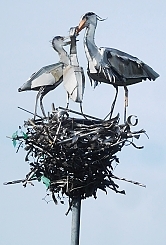 The Fantastic Herons
The Fantastic HeronsThe river was well-populated with waterfowl including swans; geese of various kinds; ducks; a pair of cormorants resting on a buoy; and several herons. The latter were either standing on the sand and mud at the waterside or in the water close to the bank. Eventually, we reached Dukes Meadows, which consists of fields formerly part of the estate of nearby Chiswick House.
Near the Hammersmith end of the Meadows, we saw a metal sculpture, ‘The Fantastic Herons’, on top of a tall pole. Created by the artist Kevin Herlihy (born 1962) along with pupils from Cavendish Primary School and unveiled in 2004, it depicts three herons standing on a nest. Like most of Herlihy’s creations which often depict animal life, it is made from recycled waste materials. Funded by Singapore Airlines, who held a series of art workshops in the school, it is an appropriate sculpture for the area as herons can often be standing by, or in, the Thames flowing past the Meadows.
April 22, 2022
Covid is over
IT WAS EASTER Saturday (2022), the sun was shining, the air was warm, and we paid a visit to the world famous, popular Portobello Road Market. For the first time after over two years of pandemic-induced suppression of London’s ‘joie-de-vivre’, the market was buzzing with activity, crowded with foreign tourists and local visitors. As it was before Covid19, the market was bustling and business at the stalls, which offer everything from artichokes to antiques and pancakes to paella, seemed to be brisk.
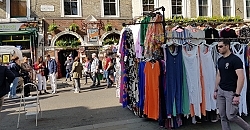 Portobello Road
Portobello RoadA friend, who lives in rural France, said to me a few days ago when we were walking near Leicester Square:
“It’s hard to believe that there was ever a deadly pandemic in this city.”
And as we walked along a short street in the area, he added:
“There are more people out in this street than there are living in my hometown.”
Yet, Covid infection rates are high in the UK. Friends in India have been telling us that they are thinking twice before visiting the UK because the risk of becoming infected here is so great at the moment. Recently, I have heard that approximately between 1 in 12 and 1 and 15 people in the UK are likely to be infected with a Covid19 virus, and therefore capable of spreading it to others.
Apart from personal hygiene and wearing face coverings, good ventilation is considered to be useful for reducing the risk of spreading the viruses. So, when I boarded a bus in South Kensington recently, I opened the window closest to me – each window on London buses has a label saying “Open this window”. Immediately after following this instruction, which has been given for reasons of prevention of infection, the lady sitting behind me, who was not wearing a face covering, stood up and slammed it shut. I stood up, opened it, and told her not to touch it. She said, speaking angrily with an Eastern European accent:
“You don’t need to open it. You are wearing mask and have three vaccinations.”
How she knew my vaccination status, I do not know. My wife said to her:
“Don’t you know that one in twelve are infected?”
To which the lady replied:
“Believe what you like.”
Then to my great surprise, she added:
“Covid is over”
April 21, 2022
Buried behind Berry Brothers
LONDON’S NOOKS AND crannies are often worth exploring. One, which I must have passed often but of whose existence I only became aware in April 2022, is Pickering Place, a narrow, covered passageway between numbers 5 and 3 St James Street, close to St James Palace. Immediately on entering this timber lined alleyway, I noticed a metal plaque, which commemorates the short-lived Legation of the Republic of Texas to The Court of St James. The legation existed from 1842 to 1845, whilst the Republic existed from 1836 to 1846. It rented the premises from the property’s owner, Berry Brothers.
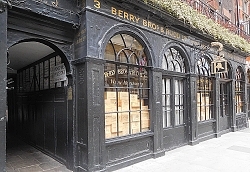
Pickering Place was in existence by 1690, when it was then known as ‘Stroud’s Court’. Prior to that date, the site was:
“… once home to the medieval maidens’ leper colony of St James, before playing host to King Henry VIII’s royal tennis court.” (https://blog.bbr.com/2015/04/10/the-other-no-3/)
The alleyway leads into a small open space, a courtyard that is believed to be Britain’s smallest square. The name Pickering relates to the company of Berry Brothers and Rudd (‘Berry’s’) that occupy most, if not all of the buildings around the courtyard and on the south side of the alleyway. In 1698, a widow with the surname Bourne began the business, at first a grocery shop, now known as Berry Brothers & Rudd. Her daughter, Elizabeth, married William Pickering (died 1734). They continued the business, supplying the coffee houses of St James with coffee. The company adopted the coffee mill as their symbol. The shop at number 3 St James Street and Stroud’s Court were then rebuilt by the family. William and Elizabeth’s sons, John and William Junior, continued the running of the firm. After John died in 1754, William Junior brought a relative, John Clarke, to be a partner in the business.
George Berry, John Clarke’s grandson, joined the business in 1803 and by 1810, his name became the firm’s name. George moved the firm’s activities into focussing on wine and spirits. In 1845, his sons, George Junior and Henry, took over the firm, hence the ‘Brothers’ in the company’s name. Hugh Rudd, a wine merchant with a keen interest in the wines of Bordeaux, joined the firm as a partner in 1920. His arrival in the company greatly increased its expertise in the wine trade. In 1923, the company created a new whisky which they called Cutty Sark Scotch. Its label was designed by the artist James McBey, whose studio was at the top end of Holland Park Avenue. The firm is still run by the Berry and Rudd families and flourishes.
Immediately after leaving the covered alleyway, you will see an orrery and beyond it, a carved stone portrait of a man with his head facing towards his left. Nobody we asked seemed to know whom it portrays. Various websites suggest it depicts the politician and former Prime Minister Lord Palmerston (1784-1865), who lived in Pickering Place for some time. The author Graham Greene also lived in Pickering Place for a while.
Doorways in the courtyard lead to various underground rooms including the Pickering and Suffolk Cellars. Once used to store wine and other products sold by Berry’s, parts of them are now also used as a wine school, as well as for banquets and similar gatherings. One of the cellars is named The Napoleon Cellar, after the exiled Napoleon III (1808-1873), a friend of George Berry Junior. In 1846, fearing assassination, the exiled Frenchman hid in the Berry Brother’s cellar, now named in his memory. Number 3 Pickering Place, built in the 1690s, is a well-preserved example of a William and Mary era townhouse.
Part of the tiny courtyard has outdoor tables and chairs. These can be used by patrons of the St Jacques restaurant, which occupies number 5 St James Street whose southern wall forms the northern wall of the alleyway. The southern wall of the passage is part of the wall of number 3, which houses the original Berry’s shop. This well-preserved historical shop is lined with wood-panelling and contains much of the old shop fittings. These include old desks, shelving with old bottles, and a large hand-operated coffee grinder. Suspended from the ceiling, there is a large grocer’s weighing scales. According to Berry’s detailed company history (www.bbr.com/about/history):
“It was in the time of William Jr. and John Clarke that the famous grocer’s weighing scales began to be used to weigh the shop’s many notable customers, a fashionable pastime that continues to this day.”
Had it not been for noticing the alleyway which I have passed often without noticing it, and then spotting the portrait in the courtyard, I doubt we would have ever entered the old shop at number 3. Incidentally, if you wish to purchase wines or spirits from Berry’s, you will need to walk around the corner into Pall Mall, where the company has a newer shop … or, less interestingly, you can make purchases online.
April 20, 2022
Forbidden radio station on a ship
FROM A FIELD on my friend’s farm in Essex, I could see the mid-morning sun glistening on the water of the estuary of the River Blackwater. Moored out on the water, there was a trawler with a red hull and white superstructure. A tall aerial mast, just about visible through the heat haze, was mounted on its deck in front of the bridge housing. When my friend saw me taking a photograph of the vessel, she mentioned what it is, and this caused distant memories to surface in my mind.
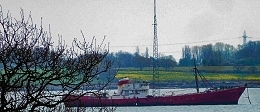
When I was a child in the early 1960s, I had a Phillips radio in my bedroom. I was a keen listener and enjoyed exploring the various stations broadcasting from all over the world. It was during this period and with this radio that, for example, I was able to tune into the propaganda-rich programmes transmitted from Albania by Radio Tirana. Less exotic than this was Radio Luxembourg, which unlike the few rather straightlaced, advert-free BBC stations, pumped out a stream of non-stop ‘pop’ music, punctuated by commercials for products, which were not aimed at audiences in little Luxembourg but instead at consumers in the UK. In those days, I was not much interested in pop music, but I enjoyed the commercials. The only one that I can remember was for a particular football pool company.
Radio Luxembourg was founded in 1933, long before I became one of its listeners. Located outside the UK, it was not subject to any of the legislation that ensured the BBC had a monopoly as a broadcaster in Britain.
In 1964, the Irish businessman Ronan O’Rahilly (1940-2020) and Alan Crawford came up with the idea of broadcasting to the UK from a ship moored in international waters. This way both the restrictive laws that protected the BBC, and the record company’s control of pop music broadcasting in the UK, were overcome. Radio Caroline was born and began broadcasting non-stop pop music from beyond Great Britain’s territorial waters. Caroline was soon followed by other radio stations, such as Radio London, which all made use of the same wheeze to get around the restrictive legislation in the UK. Radio Caroline has had a long and sometimes difficult history since its formation. This is described in great detail on the company’s website (www.radiocaroline.co.uk).
Our friend in Essex told me that what I was photographing is the boat from which Radio Caroline transmitted. I was surprised because, for no good reason, I had believed that Caroline was a thing of the past. The boat moored in the Blackwater is the Ross Revenge, formerly used as a fishing trawler. It was not the first boat to house Radio Caroline; it served this purpose between 1983 and 1991. A radio station bearing the name Caroline still functions. What is important about Radio Caroline and other so-called ‘pirate’ stations is that their existence had some considerable influence in causing the BBC to commence broadcasting pop music. Radio 1, which replaced the BBC’s Light Programme, was started in 1967 in response to the popularity of the pirate stations amongst the listening public.
I am glad that we were shown around our friend’s farm and that I spotted that boat in the estuary. Although I did not often listen to Radio Caroline, seeing the vessel made me recall my early radio receiver (‘wireless’) and the joy it gave me during my early teens.
April 19, 2022
Drawn to remember: an exhibition by an Indian painter
THE PAINTER MAHESH BALIGA was born in the south Indian state of Karnataka in 1982. He studied painting at The Chamarajendra Academy of Visual Arts (CAVA) in Mysore, and then received a postgraduate qualification at the prestigious Faculty of Fine Arts, MSU, in Baroda (Vadodara in Gujarat). He has taught at various art schools in India and exhibited in several countries including India. Currently, he lives and works in Baroda. Between the 12th of April 2022 and the 28th of May 2022, some of his works are being exhibited in a solo exhibition, “Drawn to Remember”, at the David Zwirner Gallery in Grafton Street (in London’s West End).
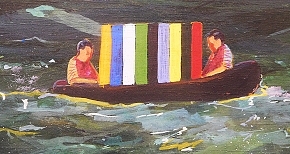
The paintings on display were created using casein tempera. This kind of paint has a glue-like consistency, but it can be thinned with water. According to Wikipedia, artists like this kind of paint because:
“… unlike gouache, it dries to an even consistency, making it ideal for murals. Also, it can visually resemble oil painting more than most other water-based paints …”
At first glance, it is difficult to discern whether the Baliga’s paintings on display at Zwirner’s resemble water colours or oil paintings; some of them seem to look halfway between the two mediums. All of them, except one, are quite small canvases and without exception they are all attractive. The subject matter depicted in the works is varied, from studies of plants and animals to everyday scenes (often with depictions of Indian life) to the slightly unusual. An example of the latter is in the only large canvas of the show in which there is an image of a man with sticky plasters over his left eye. Another odd subject shows a man with flowers growing out of his shirt. This is appropriately named “Flowering Self”.
The small size of most of the paintings, which the artist described as ‘lap-sized’, has a reason. Many of them were executed on the journeys the artist made when commuting to and from Surat (in the south of Gujarat), where he held a teaching position for a while. Though they are not large paintings, each one of them provides a window on the artist’s experiences and and his take on them. Although the paintings are far from mundane, they are not over-dramatic or excessively visually challenging. The exhibition is well worth seeing. I would be happy to hang any one of the works I saw at his exhibition on my walls at home.
April 18, 2022
Vanishing point
OF JAMAICAN HERITAGE, the artist Barbara Walker was born and brought up in Birmingham where she lives today. During her childhood, she was taken to see museums and galleries. She noticed that in many works (paintings and other images) of western art, Black people play a peripheral role, depicted as servants and so on, serving the ‘white’ people who play a central role in a picture. Recently (April 2022), we visited an exhibition of her works at the Cristea Roberts Gallery in London’s Pall Mall. Called Vanishing Point, this superb display contains artworks, prints, which address the issue that Barbara noted when she was younger.
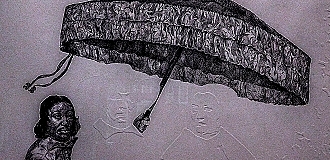
At first sight, most of the framed prints appear to be large sheets of white paper with a few beautifully drawn details depicting black people or parts of their bodies. Closer examination reveals that there is more to the white spaces than first meets the eye. The white areas are embossed. The black people, who have been drawn, are surrounded by the embossed areas of the print. Together, the drawings and embossed sections of the print can be seen to be a whole picture. Walker has processed an original image to create a new one in which only Black people in the original are easily visible and the rest of the picture forms a ghostly background. Unlike the pictures she saw when a youngster, the Black people in the picture are prominent and the others are barely detectable.
I am not sure exactly how the artist achieved this interesting effect and these powerful images, but I will have a go at explaining, using my experience of having once made etchings in the past. Metal plates are first coated with a photographic material. Then images of an original painting are projected on to it and processed in some way that produces a photographic reproduction on the plate. The artist, then blocks out selected areas on the plate with an acid-resistant material to produce a pattern that includes many details of the original image, including all of the parts of it that contain depictions of Black people or the parts of their bodies in the original painting or image. The plate is then immersed in acid, which eats into all the parts of it, which have not been painted over with the blocking agent. Then, a sheet of dampened paper is placed on the plate and the two are run through a printing press. The pressure exerted by the rollers of the press force the dampened paper into the depressions on the plate caused by the action of the acid. The result is a sheet of paper with embossed indentations. When the paper has dried, the artist then draws on the flat areas, which are in fact silhouettes of the Black people (or details of them) which appeared in the original painting. The rest of the embossed area, containing details and enough outlines of the original image to make it recognisable, is left white. The result is an image in which Black people become the focus of the viewer’s attention.
Barbara Walker’s works on show at Cristea Roberts (until the 23rd of April 2022) are ingenious and extremely engaging. She has employed an interesting technique to make her statement. Rather than reinforcing the fact that Black people were often depicted as being menial as is the case in the recent display of paintings by Hogarth at the Tate Britain, she has found a way of raising their status in artworks that sought to portray them as mere subsidiaries.
April 17, 2022
Where gold flowers grow
THE COUNTY OF ESSEX is immediately east of Greater London. Parts of it are heavily built-up and not particularly attractive. The rest of the county is both varied and delightful to explore. So near to London, many parts of it retain rural characteristics, which one might not believe existed so near to the huge city of London. Recently, we visited Goldhanger, a small village close to the River Blackwater’s estuary.
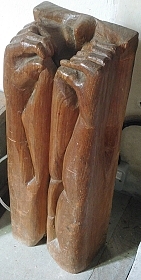 Sculpture by Horace Crawshay Frost in the parish church in Goldhanger, Essex
Sculpture by Horace Crawshay Frost in the parish church in Goldhanger, EssexThe village near Maldon (famous for its salt) has been known as ‘Goldanger’, ‘Goldangra’, and ‘Goldangre’. According to Maura Benham (1913-1994) in her history of Goldhanger, the place’s name has always had ‘gold’ as its first part. The gold probably referred to a yellow flower. The second part might either originate in the word ‘hanger’ meaning hill, or ‘anger’ meaning grassland. It is not known exactly when the settlement, which is at the head of a small creek, was first established but there is archaeological evidence suggesting it was already inhabited in the Iron Age around 500BC. One reason for the village’s existence might have been for making salt from seawater. The local saltworks came to an end in the early 19th century.
The heart of the small village is The Square, where Church, Fish, and Head Streets meet. We ate a hearty, tasty lunch in the Chequers Inn. This was listed as the only alehouse in the village in a document dated 1769. It might have been used by smugglers long ago. The building housing it has been used as a pub for at least 250 years. Prior to that it was built about 250 years earlier as a residence. Constructed in stages, the earliest part was probably built in 1500 (http://past.goldhanger.org.uk/Chequers.htm#:~:text=The%20Chequers%20has%20been%20an,landowner%20as%20his%20private%20ressidence.) Inside, the pub, built on several different levels, with an abundance of ageing timber beams, has an authentic ‘olde worlde’ atmosphere and appearance.
The pub is the southern neighbour of the attractive St Peter’s parish church. According to the architectural historian Nikolaus Pevsner, the church originated in the 11th century and some evidence of this can still be observed. The south aisle was built in the 14th century and the west tower in the 15th. Pevsner makes special mention of a tomb chest with a black stone cover plate which has indentations where several brasses used to be. This stands in the South Chapel, which was built by the local Higham family, whose farm was in Goldhanger, in the early 1500s. The chest tomb contains the remains of Thomas Heigham who died in 1531,
Although the church has many other interesting features to enjoy, I will mention only one of them. Located close to the Higham tomb, I noticed a curious wooden carving, a sculpture depicting two forearms with hands clutching or gripping something I could not identify. This was sculpted by Crawshay Frost. According to a short history of the church, this artwork was dated “1960s”. Whether that means it was placed in the church then, or created then, is not stated. I had not encountered the name Crawshay Frost before visiting Goldhanger. A fascinating web page (http://past.goldhanger.org.uk/Frost.htm) described a notable inhabitant of the village, Horace Crawshay Frost (1897-1964), who lived in Fish Street between 1926 and 1964.
Horace graduated in History at the University of Oxford. During WW1, in which he suffered injuries (both physical and psychological), he took many photographs, some of which are now kept in London’s Imperial War Museum. After leaving the army in the early 1920s, he taught at a school in Brentwood (Essex). Soon after that, he moved to Goldhanger, where he gave private tuition to the children of the curate. In Goldhanger:
“… he involved himself in local history, archaeology, art, sculpture, music, ornithology, horticulture, photography and writing, and also established a reputation as a local philanthropist of extreme intelligent. Whether it was because he was sufficiently wealthy, or because he was too ill, or both, it appears that for most of the time he lived in the village he did not engaged in any kind of full time employment, but rather he spent his time enthusiastically pursuing various hobbies and pastimes, and paid others to help him with them.”
On the basis of this information provided on the webpage, I feel that it was Horace, who produced the sculpture I saw in the church. Further evidence of his interest in wood carving comes from a book, “Celebration”, the autobiography of Graham David Smith. He recalled visiting Horace in Goldhanger in 1955, during the time of the so-called Mau-Mau Uprising in Kenya. Smith wrote:
“We had come to work and earn money. Mr Frost had a perfect job for us. Laid out in front of the open kitchen door were several mahogany beams ordered through local woodyards and a large satchel of finely honed steel chisels from Harrod’s. Mr Frost, deeply disturbed by any stories about war, had come by what he thought would be a perfect solution of that awful Mau-Mau business in Kenya: art to soothe the savage breast. To get the Africans started, he had sketched out the wood scenes and motifs he thought conducive to a peaceful and pastoral life.”
On our way from the church back to the car, I noticed three pumps on Head Street, near to the Chequers pub. Two of them, standing side by side, were old-fashioned petrol pups bearing the ‘Pratts’ logo. These well cared for objects were installed in about the 1930s, but maybe originally in Church Street. Opposite these and next to the village car park, there is another pump. This was installed to supply water.
The water pump is above a water well that was dug in the hot summer of 1921. According to a notice affixed to the hand operated pumping mechanism, the well is 70 feet deep “with a further 100 feet of artesian bore, making 170 feet in all.” In 2012, to celebrate the Diamond Jubilee of Queen Elizabeth II, Goldhanger Parish Council restored both pump and well to working condition.
Once again, a brief outing to rural Essex, albeit a small part of it, has proved to be most interesting.
April 16, 2022
From Peter Pan to Skanderbeg and some fake windows
BETWEEN LANCASTER GATE and Queensway, at the corner of Bayswater Road and Leinster Terrace, there stands number 100 Bayswater Road, which was built in 1820 and was the home of the author JM Barrie (1860-1937) from 1900 onwards. It was here close to Hyde Park that he wrote “Peter Pan” as a play in 1904 and as a novel in 1911. It is worth wandering along Leinster Terrace and its continuation Leinster Gardens.
Almost opposite Barrie’s home but a little north of it is number 74 Leinster Terrace. It was here that the American author Francis Bret Harte (1836-1902) lived and died. He had settled in London in 1885. Northwest of this house and on the south corner of the Terrace and a passageway called Craven Hill Gardens, there is a Greek restaurant that has long intrigued me. It is called Mykonos and has the Swedish words “Kalle på Spången” written on it in several prominent places. This is the name of a well-known Swedish film made in 1939, in which a character called Kalle owns and runs a pub. Formerly called Zorba’s, it was closed in 2017 because of hygiene problems. Now (2022) called Mykonos, it looks as if it is no longer in business. It also bears a sign with the name of a Swedish County, Skåne, in which the inn that figures in the film was located. Unless it was to attract Swedish tourists, I am not clear why this Greek restaurant associated itself with a Swedish film. North of the restaurant, Leinster Terrace becomes Leinster Gardens.
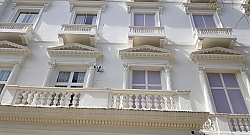 Real windows on the left and fake windows on the right
Real windows on the left and fake windows on the rightMuch of the west side of Leinster Gardens is lined by Victorian terraced housing with neo-classical features. Close examination of numbers 23 and 24 reveals that unlike their neighbours on either side, the windows do not have glass panes. Where the windowpanes should be, there are painted blanks. These two houses in the terrace were demolished when the subterranean London Underground lines were being built in the 1860s. The façades of numbers 23 and 24 have no building behind them. They hide a ventilation shaft that provides air to a section of the Circle and District lines running between Bayswater and Paddington stations. By walking along Craven Hill Gardens west to Porchester Terrace, which runs parallel to Leinster Gardens, you can see the featureless rear of the fake façade and beneath it you can just about see the tracks of the railway.
Moving north along Porchester Terrace, you can see number 30, which is adorned with a sculpted lion and some lion heads. It was here that the family of the author Wilkie Collins (1824-1889) moved from Hampstead in 1830, when he was six years old. Collins’s father, William Collins (1788-1847) was a painter, whose paintings at one time exceeded those of John Constable in value. Another artist, John Linell (1792-1882), a friend of William, lived a few doors north of this at number 36 from 1830 until 1851. Many years later, this house was occupied by the photographer Camille Silvy (1834-1910) between 1859 until 1868.
Not far away from Porchester Terrace and close to Queensway, a sculpted bust of a man in a distinctive helmet stands on a plinth at the corner of Inverness Terrace and Porchester Gardens. This depicts Albania’s most highly regarded hero George Kastrioti Skanderbeg (1405-1468), who defended his native Albanian territory from the invading Ottoman armies for a few years.
Between Peter Pan’s birthplace and the monument to Albania’s national hero is a few feet more than one third of a mile on foot. Yet in this short distance, there is much to see. This is what makes London such a fascinating place in which to live.
April 15, 2022
Remembered with yellow flowers
THE NORTH FLOWER Walk in Kensington Gardens runs east from the Italian Gardens. It is both close to, and parallel to, Bayswater Road. About 280 yards west of the Italian Gardens, there is a small, low rectangular memorial stone in a flower bed next to the North Flower Walk. In springtime, a large bush behind it bursts into yellow flowers. It is a forsythia plant.
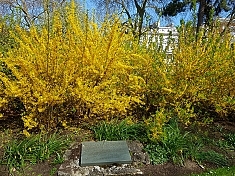
The North Flower Walk used to be a part of what was once the ‘berceau’ or ‘walk of shade’. According to a document published on the Royal Parks website, this was:
“… a delicious and appealing place to stroll for the monarch on the way to … the site of the Bayswater ‘Breakfasting House’…”
Today, the Walk is filled with walkers, their children, their dogs, joggers, and the occasional cyclists.
The memorial stone celebrates the botanist and horticulturalist William Forsyth (1737-1804). A founding member of The Royal Horticultural Society (founded 1804), he was also the Curator of The Chelsea Physic Garden (from 1771) and Superintendent of various royal gardens including those of Kensington Palace (from 1784). The plant genus Forsythia, a member of the olive family (Oleaceae), was named in his honour.
April 14, 2022
A road with many names
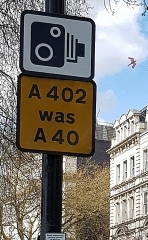
THE WESTERN END of Oxford Street is at Marble Arch. Beyond the latter, its continuation becomes Hyde Park Place and then, after 620 yards it becomes Bayswater Road, before reaching Notting Hill Gate, and then Holland Park Avenue. Oxford Street and its continuation westward follow the probable course of a road or track named by the Romans as Via Trinobantia. It ran from Colchester via London to Silchester (in Hampshire), which was a capital of the Atrebates tribe. According to Ralph Merrifield in his “Roman London” (published 1969), the Roman thoroughfare ran due west from Oxford Street, along what is now Bayswater Road to Notting Hill Gate. After that, it changed direction so that it headed directly to what is now Staines. Merrifield wrote that its course:
“… is closely followed by Holland Park Avenue and Goldhawk Road, until the latter turns sharply towards Chiswick. The Roman road is then followed by two lesser modern roads, Stamford Brook Road and Bath Road, and crossed Acton Green where it has been obliterated by the railways. Half a mile further west it is represented by Chiswick Road, which leads to Chiswick High Road…”
On a map drawn by Ralph Agas (c1540-1621) in the 16th century, the part of the Roman highway known now as Oxford Street was marked “The Waye to Uxbridge”. At that distant time (1561), the western edge of London was as far east as Farringdon, which follows part of the now lost Fleet River. This was the case except for riverside strip of buildings along the north bank of the Thames to Westminster. Oxford Street, so named in the 18th century, has had other names such as the ‘Tyburn Road’, ‘Uxbridge Road’, and ‘Oxford Road’.
A sign on a lamppost on Bayswater Road near to Lancaster Gate Underground station reads “A402 was A40”. The road running along the northern edge of Hyde Park and Kensington Gardens was designated in 1923 as ‘The London to Fishguard Trunk Road (A40)’. After the A40 was re-routed, part of it running along the elevated Westway (completed in 1970), the section of the original A40 (and much earlier the Roman road), which ran between Marble Arch and the westernmost end of Goldhawk Road was re-designated the A 402.
Until the early 19th century, what is now Bayswater Road and its western continuation ran through open country, passing Hyde Park, a royal hunting ground established by King Henry VIII in 1536 (and opened to the public in 1637). Before the park was established, the journey west of what is now marble Arch would have been through a rustic landscape and travellers would have been at risk from attacks by robbers, Today, the greatest risk faced by users of Bayswater Road is delay caused by traffic congestion.



